Assessment of Water Consumption Behavior in Single Households Using Smart Water Meters
Abstract
:1. Introduction
2. Materials and Methods
2.1. Study Area
2.2. Data Collection
2.3. Data Analysis
3. Results
3.1. Temporal Trends in Water Consumption among All Households
3.2. Categorization of Single Households by Smart Water Meter Data
3.3. Analyzing Hourly Water Consumption, Demand Timings, and Behavior Activities between Single Households: Worker vs. Nonworker
4. Discussion
5. Conclusions
Author Contributions
Funding
Institutional Review Board Statement
Informed Consent Statement
Data Availability Statement
Acknowledgments
Conflicts of Interest
References
- Farah, E.; Shahrour, I. Leakage Detection Using Smart Water System: Combination of Water Balance and Automated Minimum Night Flow. Water Resour. Manag. 2017, 31, 4821–4833. [Google Scholar] [CrossRef]
- Depuru, S.S.S.R.; Wang, L.; Devabhaktuni, V. Smart Meters for Power Grid: Challenges, Issues, Advantages and Status. Renew. Sustain. Energy Rev. 2011, 15, 2736–2742. [Google Scholar] [CrossRef]
- Stewart, R.A.; Willis, R.; Giurco, D.; Panuwatwanich, K.; Capati, G. Web-Based Knowledge Management System: Linking Smart Metering to the Future of Urban Water Planning. Aust. Plan. 2010, 47, 66–74. [Google Scholar] [CrossRef]
- Cole, G.; O’Halloran, K.; Stewart, R.A. Time of Use Tariffs: Implications for Water Efficiency. Water Supply 2012, 12, 90–100. [Google Scholar] [CrossRef]
- Parker, J.M.; Wilby, R.L. Quantifying Household Water Demand: A Review of Theory and Practice in the UK. Water Resour. Manag. 2013, 27, 981–1011. [Google Scholar] [CrossRef]
- Clarke, A.; Grant, N.; Thornton, J. Quantifying the Energy and Carbon Effects of Water Saving; Full Technical Report; Elemental Solutions: Towcester, UK, 2009; Available online: https://www.waterwise.org.uk/wp-content/uploads/2018/02/Energy-Saving-Trust-2009_Quantifying-the-Energy-and-Carbon-Effects-of-Water-Saving_Full-Technical-Report.pdf (accessed on 30 August 2024).
- Thumim, J.; White, V.; Redgrove, Z.; Roberts, S. Energy Tariffs for Sustainability. In Waste Not, Want Not Energy Tariffs for Sustainability; Centre for Sustainable Energy: Bristol, UK, 2007; Available online: https://assets.wwf.org.uk/downloads/energy_tariffs_report_1.pdf (accessed on 30 August 2024).
- Roberts, P. Yarra Valley Water 2004 Residential End Use Measurement Study; California Energy Commission: Sacramento, CA, USA, 2005. Available online: https://efiling.energy.ca.gov/GetDocument.aspx?tn=71104& (accessed on 30 August 2024).
- Sivakumaran, S.; Aramaki, T. Estimation of Household Water End Use in Trincomalee, Sri Lanka. Water Int. 2010, 35, 94–99. [Google Scholar] [CrossRef]
- Beal, C.D.; Stewart, R.A. South East Queensland Residential End Use Study: Final Report; Reports; Griffith University: Queensland, Australia, 2011; Available online: https://research-repository.griffith.edu.au/bitstream/handle/10072/46802/80687_2.pdf (accessed on 30 August 2024).
- Deoreo, W.B.; Mayer, P.W. Insights into Declining Single-Family Residential Water Demands. J. Am. Water Works Assoc. 2012, 104, E383–E394. [Google Scholar] [CrossRef]
- Chen, H.; Zhang, Y.; Ma, L.; Liu, F.; Zheng, W.; Shen, Q.; Zhang, H. Change of Water Consumption and Its Potential Influential Factors in Shanghai: A Cross-Sectional Study. BMC Public Health 2012, 12, 450. [Google Scholar] [CrossRef]
- Xie, Y.; Dai, W.; Xiang, S.; Deng, H.; Wang, Z.; Li, Y.; Wang, Z.; Zhou, M.; Gao, M. Supply and Demand of Ecosystem Services and Their Interaction with Urbanization: The Case of Chengdu-Chongqing Urban Agglomeration. Urban Clim. 2024, 55, 101978. [Google Scholar] [CrossRef]
- Anandhavalli, D.; Sangeetha, K.S.; Priya Dharshini, V.; Lukshana Fathima, B. Smart Meter for Water Utilization using IoT. Int. Res. J. Eng. Technol. 2018, 5, 1002–1005. Available online: https://www.irjet.net/archives/V5/i4/IRJET-V5I4221.pdf (accessed on 30 August 2024).
- Slaný, V.; Lučanský, A.; Koudelka, P.; Mareček, J.; Krčálová, E.; Martínek, R. An Integrated IoT Architecture for Smart Metering Using Next Generation Sensor for Water Management Based on LoRaWAN Technology: A Pilot Study. Sensors 2020, 20, 4712. [Google Scholar] [CrossRef] [PubMed]
- Boyle, T.; Giurco, D.; Mukheibir, P.; Liu, A.; Moy, C.; White, S.; Stewart, R. Intelligent Metering for Urban Water: A Review. Water 2013, 5, 1052–1081. [Google Scholar] [CrossRef]
- Stewart, R.A.; Nguyen, K.; Beal, C.; Zhang, H.; Sahin, O.; Bertone, E.; Vieira, A.S.; Castelletti, A.; Cominola, A.; Giuliani, M.; et al. Integrated Intelligent Water-Energy Metering Systems and Informatics: Visioning a Digital Multi-Utility Service Provider. Environ. Model. Softw. 2018, 105, 94–117. [Google Scholar] [CrossRef]
- Creaco, E.; Campisano, A.; Fontana, N.; Marini, G.; Page, P.R.; Walski, T. Real Time Control of Water Distribution Networks: A State-of-the-Art Review. Water Res. 2019, 161, 517–530. [Google Scholar] [CrossRef]
- Giurco, D.P.; White, S.B.; Stewart, R.A. Smart Metering and Water End-Use Data: Conservation Benefits and Privacy Risks. Water 2010, 2, 461–467. [Google Scholar] [CrossRef]
- Antzoulatos, G.; Mourtzios, C.; Stournara, P.; Kouloglou, I.O.; Papadimitriou, N.; Spyrou, D.; Mentes, A.; Nikolaidis, E.; Karakostas, A.; Kourtesis, D.; et al. Making Urban Water Smart: The SMART-WATER Solution. Water Sci. Technol. 2020, 82, 2691–2710. [Google Scholar] [CrossRef] [PubMed]
- Monks, I.; Stewart, R.A.; Sahin, O.; Keller, R. Revealing Unreported Benefits of Digital Water Metering: Literature Review and Expert Opinions. Water 2019, 11, 838. [Google Scholar] [CrossRef]
- March, H.; Morote, Á.-F.; Rico, A.-M.; Saurí, D. Household Smart Water Metering in Spain: Insights from the Experience of Remote Meter Reading in Alicante. Sustainability 2017, 9, 582. [Google Scholar] [CrossRef]
- Homma, Y.; Iizuka, N. Japan’s First Large Scale Efforts on the Model Project of Smart Water Meter; Bureau of Waterworks, Tokyo Metropolitan Government: Tokyo, Japan, 2018. Available online: https://www.waterworks.metro.tokyo.lg.jp/files/items/30203/File/o4-1.pdf (accessed on 30 August 2024).
- Booysen, M.J.; Visser, M.; Burger, R. Temporal Case Study of Household Behavioural Response to Cape Town’s “Day Zero” Using Smart Meter Data. Water Res. 2019, 149, 414–420. [Google Scholar] [CrossRef]
- JWRC. Smart Water Metering in Japan; Japan Water Research Center: Tokyo, Japan, 2016; Available online: https://www.jwrc-net.or.jp/english/docs/english/research/smart_water_metering.pdf (accessed on 30 August 2024).
- Msamadya, S.; Joo, J.C.; Lee, J.M.; Choi, J.S.; Lee, S.; Lee, D.J.; Go, H.W.; Jang, S.Y.; Lee, D.H. Role of Water Policies in the Adoption of Smart Water Metering and the Future Market. Water 2022, 14, 826. [Google Scholar] [CrossRef]
- Cominola, A.; Nguyen, K.; Giuliani, M.; Stewart, R.A.; Maier, H.R.; Castelletti, A. Data Mining to Uncover Heterogeneous Water Use Behaviors from Smart Meter Data. Water Resour. Res. 2019, 55, 9315–9333. [Google Scholar] [CrossRef]
- Zhang, H.H.; Brown, D.F. Understanding Urban Residential Water Use in Beijing and Tianjin, China. Habitat. Int. 2005, 29, 469–491. [Google Scholar] [CrossRef]
- Domene, E.; Saurí, D. Urbanisation and Water Consumption: Influencing Factors in the Metropolitan Region of Barcelona. Urban Stud. 2006, 43, 1605–1623. [Google Scholar] [CrossRef]
- Harlan, S.L.; Yabiku, S.T.; Larsen, L.; Brazel, A.J. Household Water Consumption in an Arid City: Affluence, Affordance, and Attitudes. Soc. Nat. Resour. 2009, 22, 691–709. [Google Scholar] [CrossRef]
- House-Peters, L.A.; Chang, H. Urban Water Demand Modeling: Review of Concepts, Methods, and Organizing Principles. Water Resour. Res. 2011, 47, W05401. [Google Scholar] [CrossRef]
- Ouyang, Y.; Wentz, E.A.; Ruddell, B.L.; Harlan, S.L. A Multi-Scale Analysis of Single-Family Residential Water Use in the Phoenix Metropolitan Area. J. Am. Water Resour. Assoc. 2014, 50, 448–467. [Google Scholar] [CrossRef]
- Antunes, A.; Andrade-Campos, A.; Sardinha-Lourenço, A.; Oliveira, M.S. Short-Term Water Demand Forecasting Using Machine Learning Techniques. J. Hydroinform. 2018, 20, 1343–1366. [Google Scholar] [CrossRef]
- Benítez, R.; Ortiz-Caraballo, C.; Preciado, J.C.; Conejero, J.M.; Sánchez Figueroa, F.; Rubio-Largo, A. A Short-Term Data Based Water Consumption Prediction Approach. Energies 2019, 12, 2359. [Google Scholar] [CrossRef]
- Maruyama, Y.; Yamamoto, H. A Study of Statistical Forecasting Method Concerning Water Demand. Procedia Manuf. 2019, 39, 1801–1808. [Google Scholar] [CrossRef]
- Niknam, A.; Zare, H.K.; Hosseininasab, H.; Mostafaeipour, A.; Herrera, M. A Critical Review of Short-Term Water Demand Forecasting Tools—What Method Should I Use? Sustainability 2022, 14, 5412. [Google Scholar] [CrossRef]
- Villar Miguelez, C.; Monzon Baeza, V.; Parada, R.; Monzo, C. Guidelines for Renewal and Securitization of a Critical Infrastructure Based on IoT Networks. Smart Cities 2023, 6, 728–743. [Google Scholar] [CrossRef]
- Keselman, H.J.; Huberty, C.J.; Lix, L.M.; Olejnik, S.; Cribbie, R.A.; Donahue, B.; Kowalchuk, R.K.; Lowman, L.L.; Petoskey, M.D.; Keselman, J.C.; et al. Statistical Practices of Educational Researchers: An Analysis of Their ANOVA, MANOVA, and ANCOVA Analyses. Rev. Educ. Res. 1998, 68, 350–386. [Google Scholar] [CrossRef]
- Beal, C.D.; Stewart, R.A.; Fielding, K. A Novel Mixed Method Smart Metering Approach to Reconciling Differences between Perceived and Actual Residential End Use Water Consumption. J. Clean. Prod. 2013, 60, 116–128. [Google Scholar] [CrossRef]
- JWWA. The Present Condition of the Water Service in Japan; Japan Water Supply Data Report 2003; Japan Water Works Association: Tokyo, Japan, 2003; Available online: http://www.jwwa.or.jp/english/water_en/water-e02.html (accessed on 30 August 2024).
- Klein, C. Average Daily Consumption Volume of Domestic Water per Person in Japan from Fiscal Year 2010 to 2019. Available online: https://www.statista.com/statistics/1193527/japan-average-daily-consumption-volume-domestic-water-per-person/ (accessed on 30 August 2024).
- Obringer, R.; Nateghi, R.; Knee, J.; Madani, K.; Kumar, R. Urban Water and Electricity Demand Data for Understanding Climate Change Impacts on the Water-Energy Nexus. Sci. Data 2024, 11, 108. [Google Scholar] [CrossRef] [PubMed]
- Wang, R.; Zhao, X.; Qiu, H.; Cheng, X.; Liu, X. Uncovering Urban Water Consumption Patterns through Time Series Clustering and Entropy Analysis. Water Res. 2024, 262, 122085. [Google Scholar] [CrossRef] [PubMed]
- Abu-Bakar, H.; Williams, L.; Hallett, S.H. A Review of Household Water Demand Management and Consumption Measurement. J. Clean. Prod. 2021, 292, 125872. [Google Scholar] [CrossRef]
- Hosoi, N.; Horii, K.; Sato, K. Clarification of the actual condition of water use classified by purpose at home in Tokyo by water amount measurement. In Proceedings of the IWA World Water Congress & Exhibition, Tokyo, Japan, 16–21 September 2018; Available online: https://iwa-network.org/wp-content/uploads/2019/10/2018_IWA_WWCE-Tokyo_Report.pdf (accessed on 26 September 2024).
- Syrmos, E.; Sidiropoulos, V.; Bechtsis, D.; Stergiopoulos, F.; Aivazidou, E.; Vrakas, D.; Vezinias, P.; Vlahavas, I. An Intelligent Modular Water Monitoring IoT System for Real-Time Quantitative and Qualitative Measurements. Sustainability 2023, 15, 2127. [Google Scholar] [CrossRef]
- Gautam, G.; Sharma, G.; Magar, B.T.; Shrestha, B.; Cho, S.; Seo, C. Usage of IoT Framework in Water Supply Management for Smart City in Nepal. Appl. Sci. 2021, 11, 5662. [Google Scholar] [CrossRef]
- Horsburgh, J.S.; Leonardo, M.E.; Abdallah, A.M.; Rosenberg, D.E. Measuring water use, conservation, and differences by gender using an inexpensive, high frequency metering system. Environ. Model. Softw. 2017, 96, 83–94. [Google Scholar] [CrossRef]

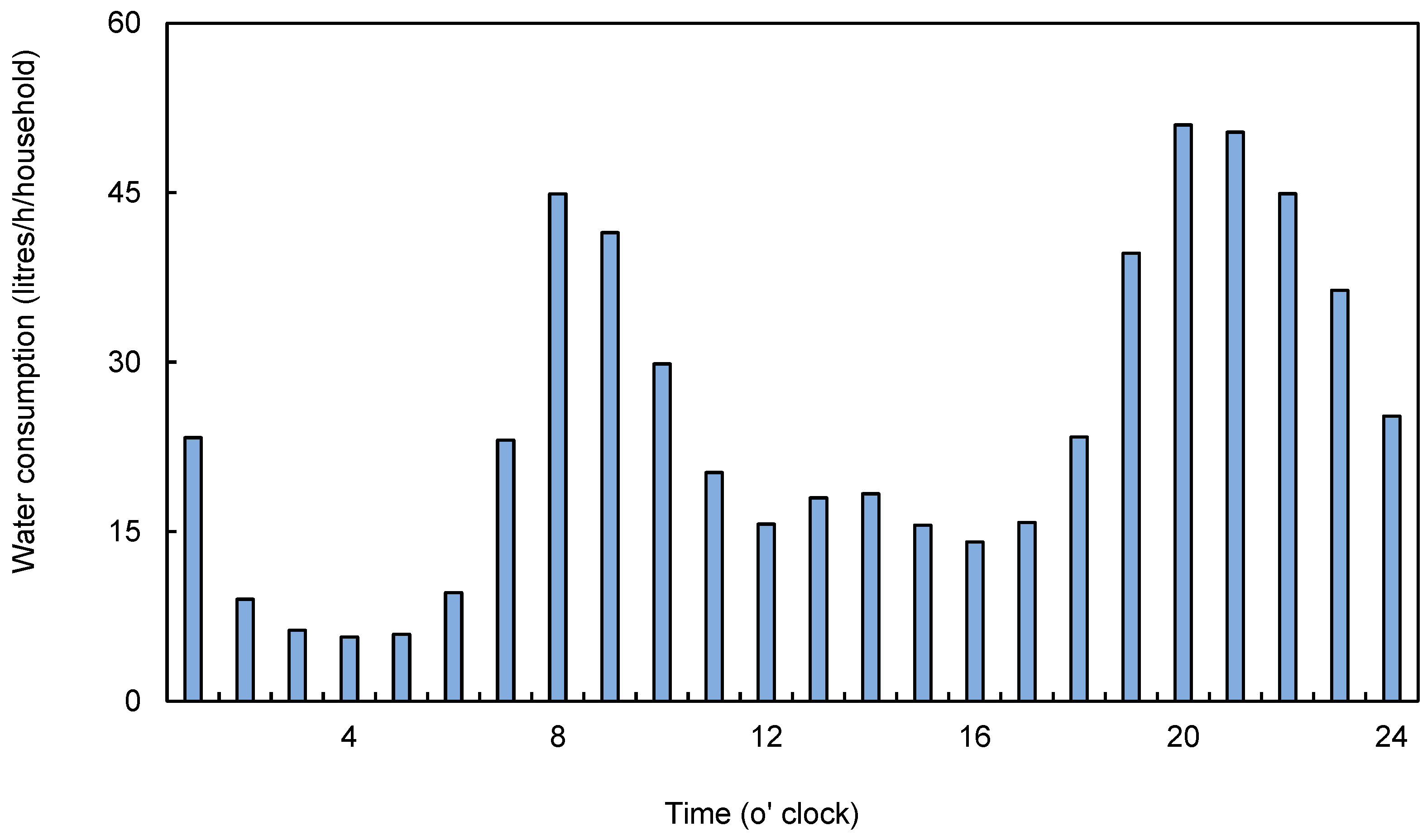
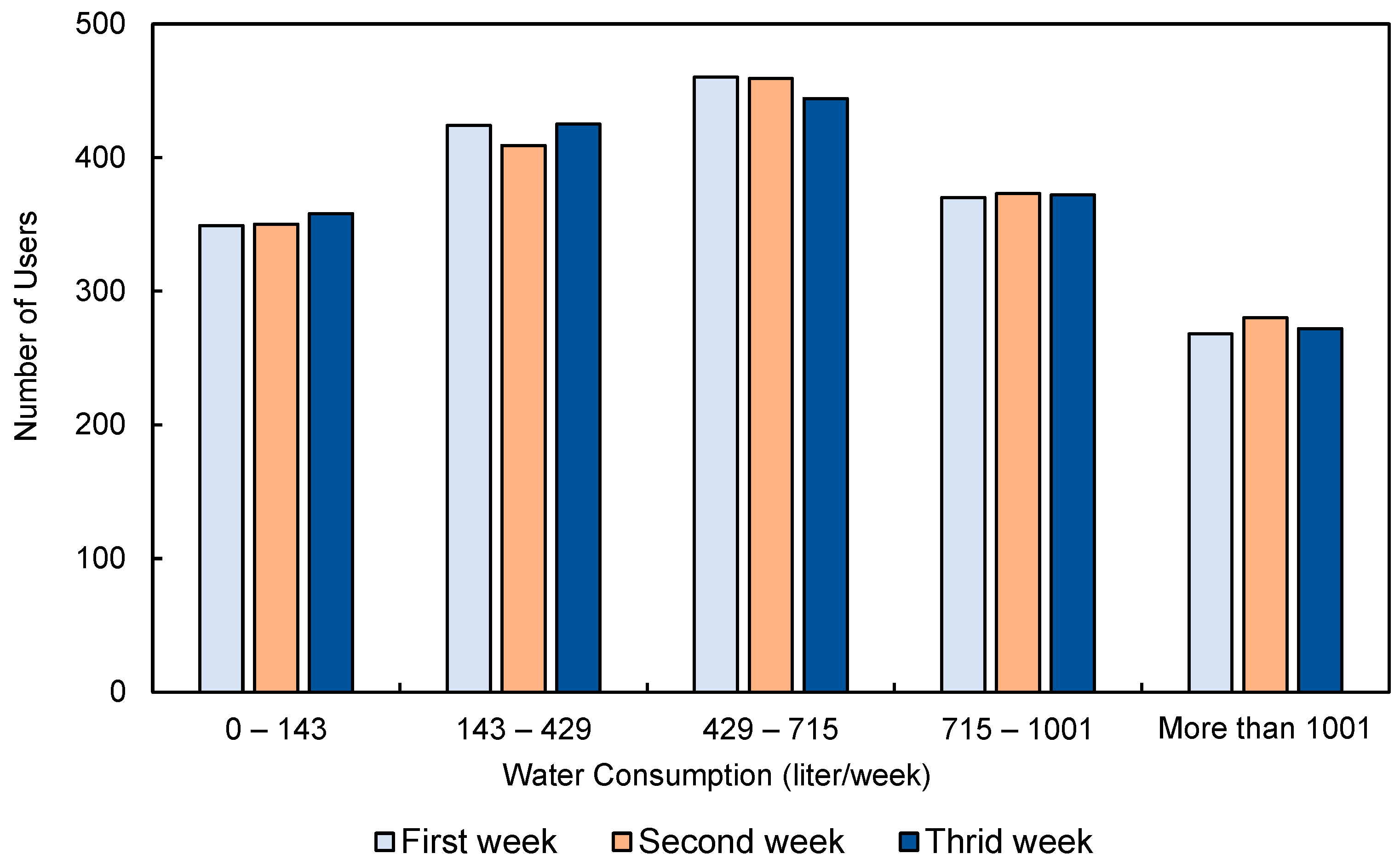
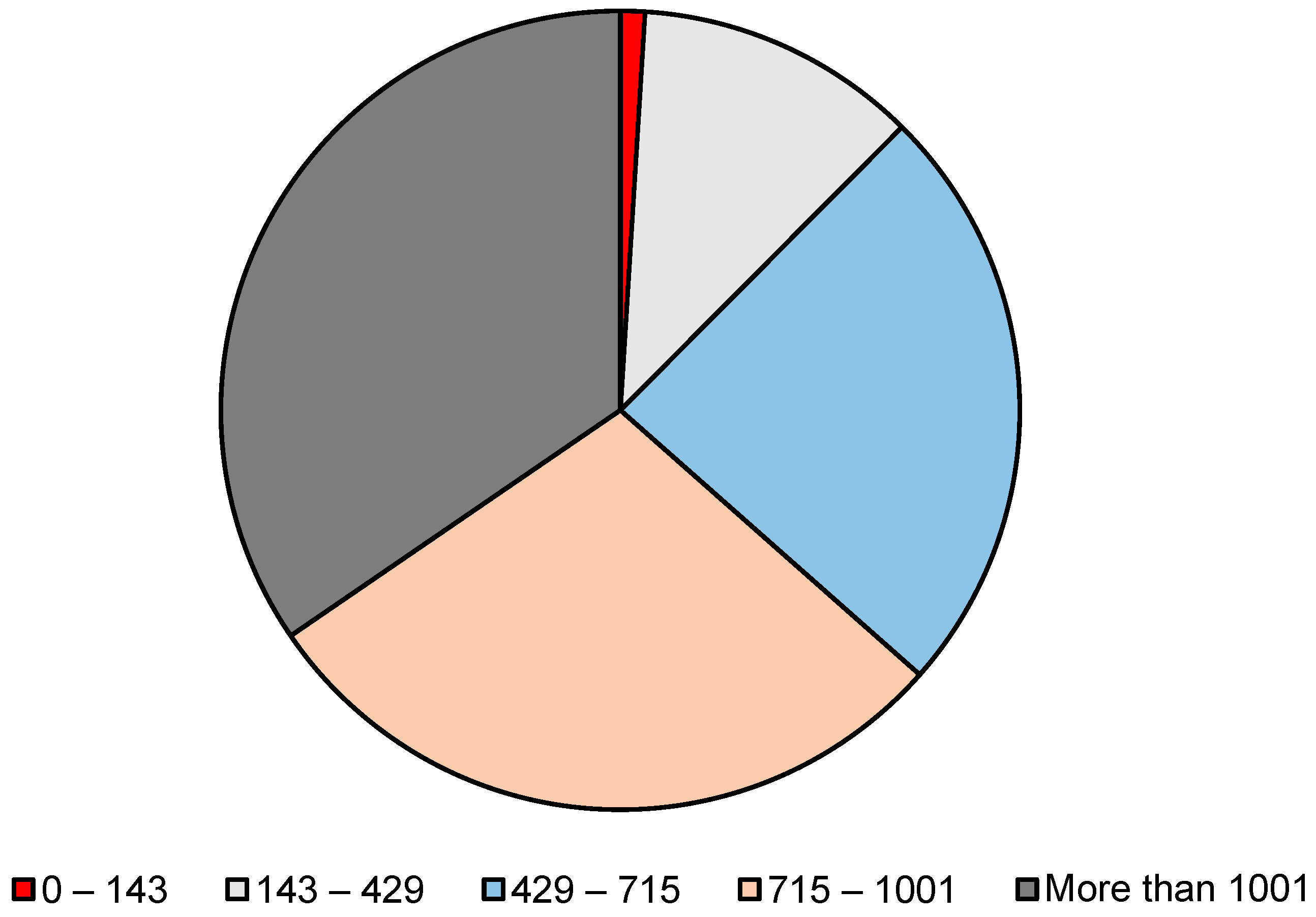
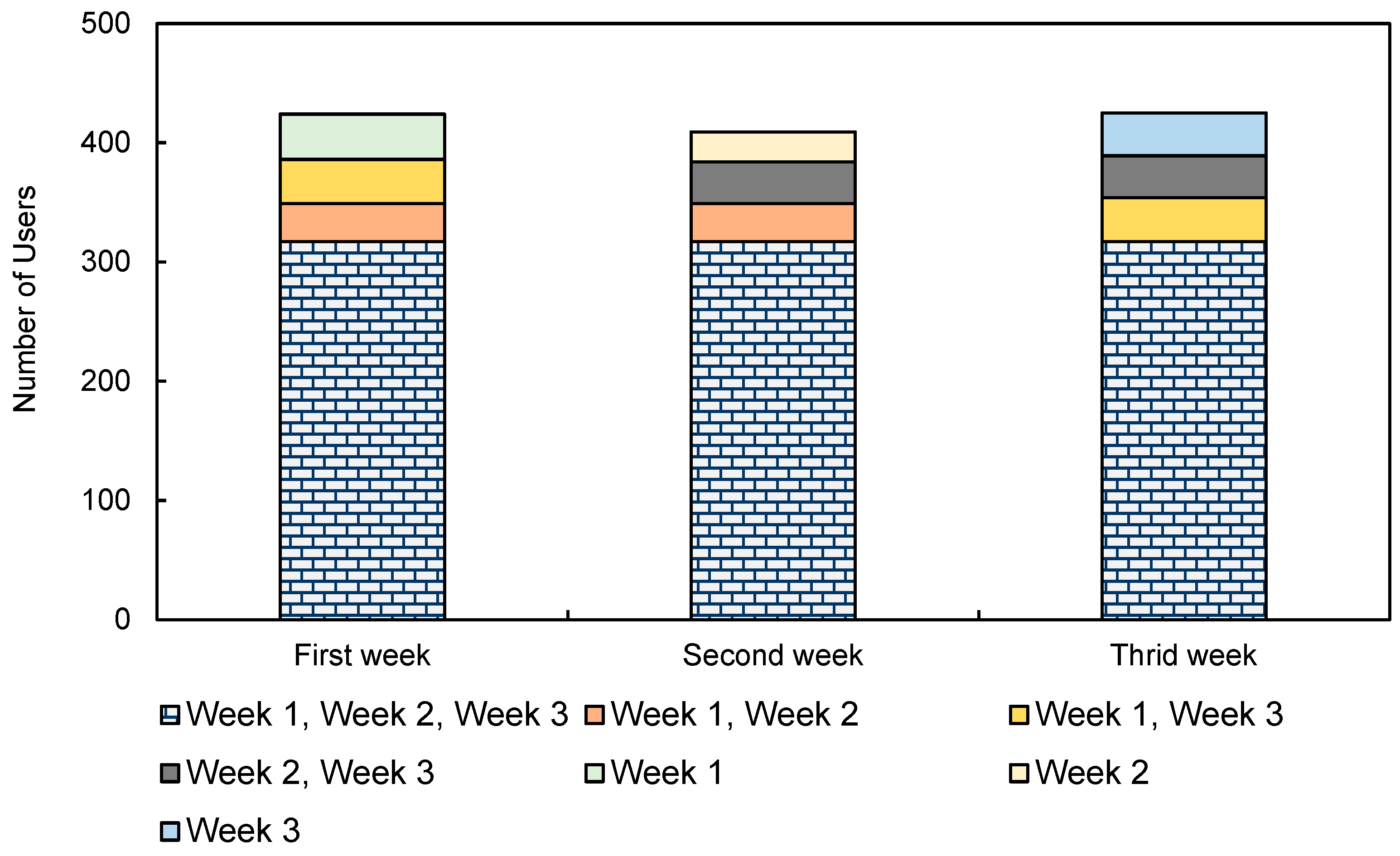

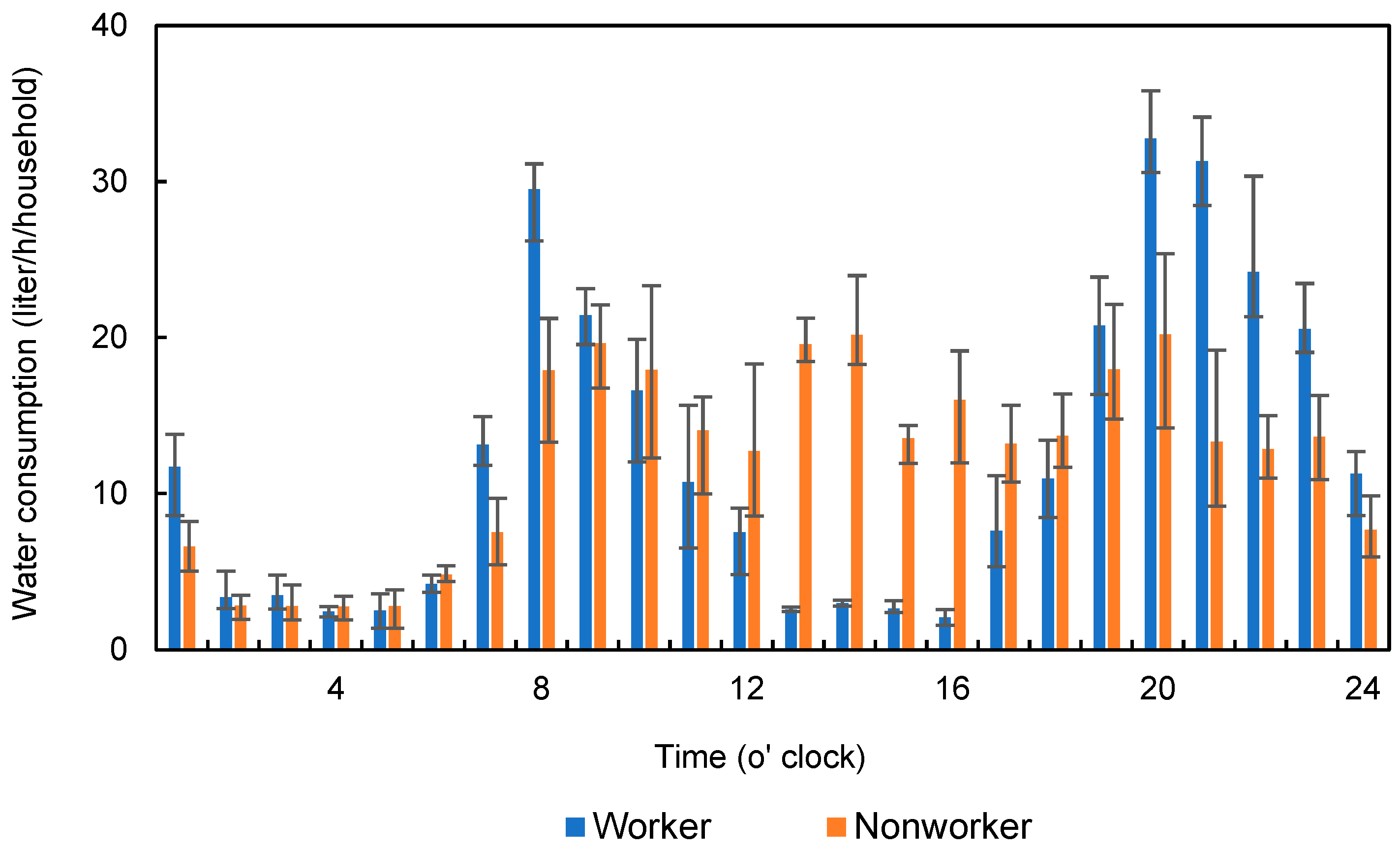

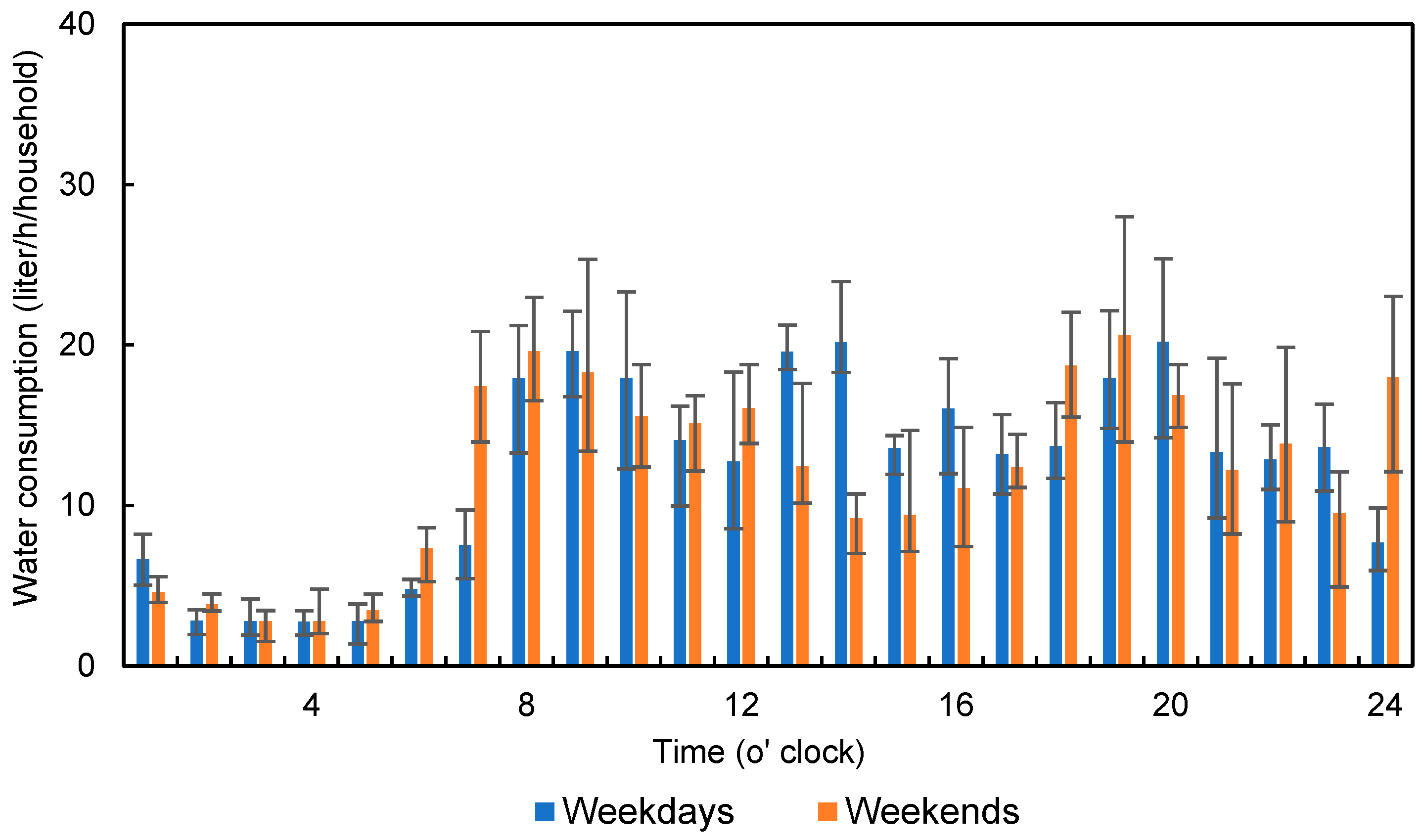
| Weekends–Weekdays (%) | Worker | Nonworker |
|---|---|---|
| Total water consumption | 110% | 99% |
| 13:00~16:00 | 362% | 60% |
Disclaimer/Publisher’s Note: The statements, opinions and data contained in all publications are solely those of the individual author(s) and contributor(s) and not of MDPI and/or the editor(s). MDPI and/or the editor(s) disclaim responsibility for any injury to people or property resulting from any ideas, methods, instructions or products referred to in the content. |
© 2024 by the authors. Licensee MDPI, Basel, Switzerland. This article is an open access article distributed under the terms and conditions of the Creative Commons Attribution (CC BY) license (https://creativecommons.org/licenses/by/4.0/).
Share and Cite
Obaid, S.; Hosoi, K.; Ngoc, N.M.; Inoue, T.; Yokota, K. Assessment of Water Consumption Behavior in Single Households Using Smart Water Meters. Appl. Sci. 2024, 14, 8857. https://doi.org/10.3390/app14198857
Obaid S, Hosoi K, Ngoc NM, Inoue T, Yokota K. Assessment of Water Consumption Behavior in Single Households Using Smart Water Meters. Applied Sciences. 2024; 14(19):8857. https://doi.org/10.3390/app14198857
Chicago/Turabian StyleObaid, Samim, Kyotaro Hosoi, Nguyen Minh Ngoc, Takanobu Inoue, and Kuriko Yokota. 2024. "Assessment of Water Consumption Behavior in Single Households Using Smart Water Meters" Applied Sciences 14, no. 19: 8857. https://doi.org/10.3390/app14198857






